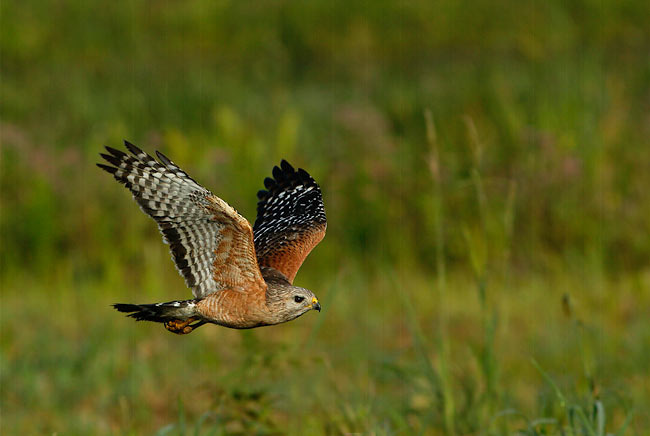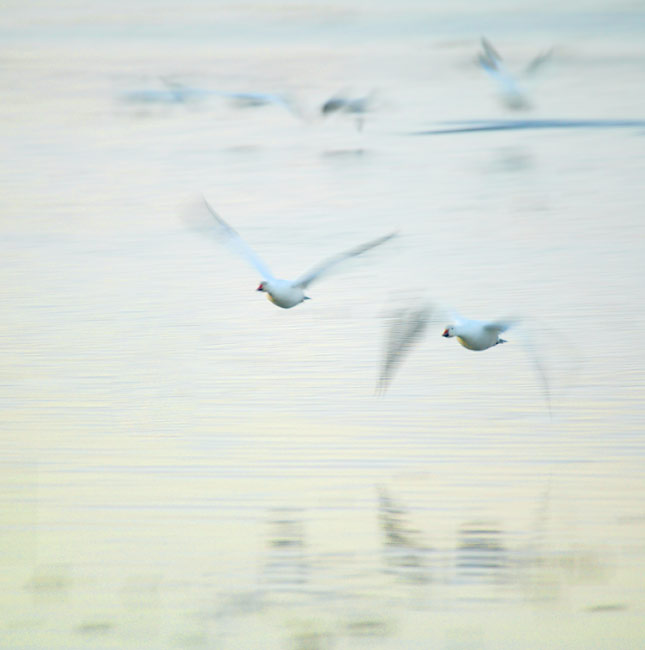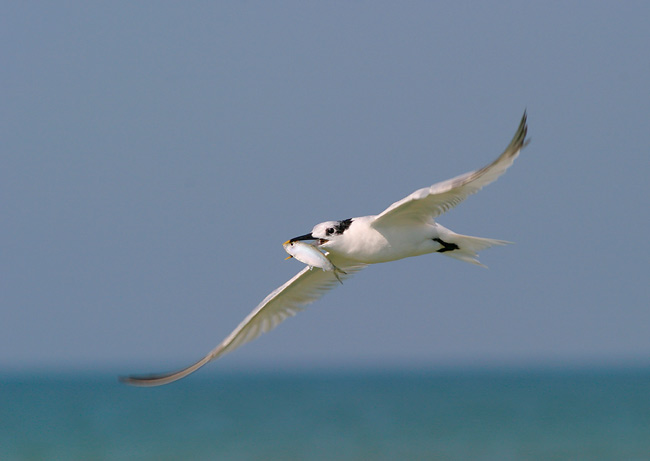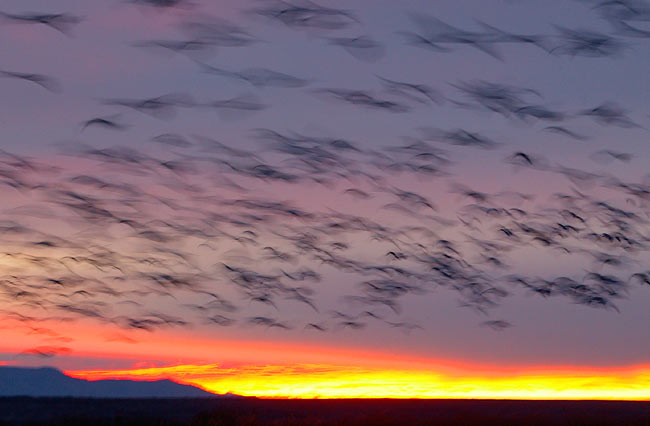
http://www.birdsasart.com/laphotoweekend.htm
The Saturday Seminar is in Torrance and the ITF-Workshops will be at Bolsa Chica, so folks from San Diego can make a weekend of it by attending the LA Zoo Day on Sunday. (I will be doing an afternoon presentation there.) If you have any other ideas as to how to promote these events, please do call or e-mail.

Snow Geese
Leaving at
Dawn... Bosque
Del Apache NWR,
NM
Image copyright
2003 Arthur
Morris/BIRDS AS
ART
Canon EOS 1Ds, 100-400mm ISO L lens at 400mm, handheld, IS 2 mode for panning.
ISO 100.
Evaluative
metering +1 2/3
stops set
manually: 1/25
sec. at f/5.6
At Bosque the
1-4 has become
my favorite
lens. With the
incredible variety
of situations
that await
visiting
photographers,
the ability to
frame at focal
lengths ranging
from 100 to
400mm is
invaluable.
The Canon EF 100-400mm zoom is the heaviest and the slowest to acquire focus but is by far the most versatile with it's great zoom range. For folks who do general nature and other types of general photography (not just birds), this lens would seem to be the obvious choice. At places like Bosque Del Apache, or when on safari, this lens is invaluable. With an extension tube or two, it--like the 300mm f/4 L IS lens, makes a great quasi macro lens for large flowers, frogs, dragonflies, and the like. Add the 500D two-element diopter and you can be doing life-size plus! This lens is, however, not the sturdiest lens ever made; lots of folks including me have had problems with this lens (not only with the IS unit but with the zooming mechanism as well). Others have used their 1-4s for years without a single problem.

Sandwich Tern
with baitfish,
Fort DeSoto
Park, FL
Image
copyright 2003
Arthur
Morris/BIRDS
AS ART
Canon EOS 10D, 400mm f/5.6 L lens.
ISO 200. Evaluative metering -2/3 stop: 1/1000 at f/10.
The old 400 is still--IMHO--the best flight lens in the world. While the 400mm f/4 DO lens will focus faster, the far lighter weight of the "toy lens" makes it #1 for flight in my book. With a 10D body, the effective 640mm focal length gives you incredible reach and in addition, "slows down" the bird's speed relative to your position, making it easier to follow the birds in flight.
For info on the Fort DeSoto/Sarasota IPT (March 26-28, 2004) visit: http://www.birdsasart.com/tours.html and scroll down.

Snow Geese at
dawn, Bosque Del
Apache NWR, NM
Image copyright
2003 Arthur
Morris/BIRDS AS
ART
Canon EOS 1D, 100-400mm IS lens at 180mm (handheld).
ISO 800. Evaluative metering +2/3 stop: , set manually: 1/10 second at f/8.
It was on my first
digital trip that I
learned that
effective blurs
could be made at
slower shutter
speeds than I'd ever
imagined
provided that the
birds were distant.
THANKSGIVING AT BOSQUE/IPT UPDATE
I am flying to Bosque on 21 November for the ninth straight year since Elaine's death on November 20, 1994. Each trip is somewhat of a pilgrimage to her memory and the wonderful years that we had together. As of this very moment, there is only a single slot left on the first IPT (NOV 23-25). The second IPT has been sold out for while. Friend and Digital & Photoshop expert Ellen Anon will be joining me as co-leader and will present a one-hour Photoshop Basics program on each tour.
As many of you know, I have, for the past several years, hosted a Thanksgiving Day Buffet lunch at the historic Val Verde Steakhouse in Socorro for birders, photographers and friends. The food is incredibly good, with tons of turkey and stuffing and yams and all the fixings as well as table-fuls of great desserts--save me lord! This year we will meet at 12:30 pm. All are invited. Bring some pix to show off. I hope that you can join us this year. (Please e-mail to let me know that you are coming.)
TIM GREY'S AMAZING DDQ (DAILY DIGITAL QUESTIONS)
Tim Grey, who works for George Lepp and teaches Photoshop at the Lepp Institute of Digital Imaging (http://www.leppphoto.com/workshops.htm), offers a free daily newsletter in which he answers a great variety of questions having to do with digital photography. You can subscribe here: http://www.timgrey.com/ddq/
Note also:
If you find the information provided in the Digital Darkroom Questions (DDQ) e-mail service to be of value, you can make a contribution to help support the effort that is put into the service. The service is provided by Tim Grey with no compensation except the contributions of supporters. For details, visit: www.timgrey.com/ddq/
Sending Questions
At this time Tim is only able to answer questions submitted by contributors. If you are interested in becoming a contributor, please visit www.timgrey.com/ddq/ and scroll down. Tim is simply unable to answer questions from non-contributors due to time constraints.
Artie
Note: Arthur Morris has been a Canon contract photographer since 1994 and continues in that role today. Hunt's Photo of Boston, MA is a BIRDS AS ART sponsor, as is Delkin Devices. Do feel free to forward this Bulletin to one or more photographer-friends. Those wishing to subscribe click here mailto:http://birdsasart.us1.list-manage.com/subscribe?u=94ad23bd96f48a1de2ca612b3&id=bdb4a511a0?subject=subscribesubject=subscribe If you received this bulletin in error, or would like your name removed from the subscriber list click here birdsasart@verizon.net?subject=unsubscribe Back issues of relevant Bulletins are archived on the web site at: http://www.birdsasart.com/bn.html